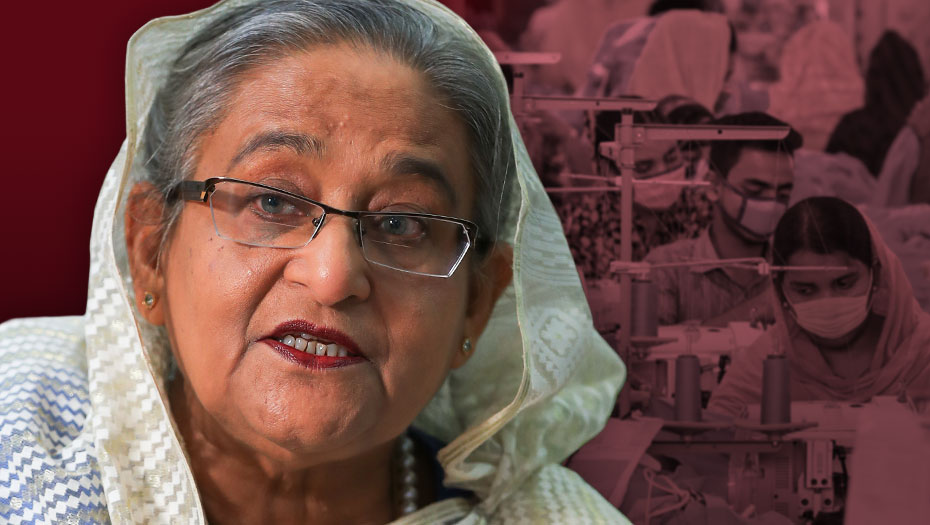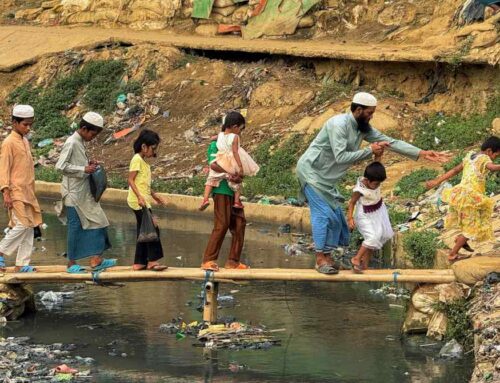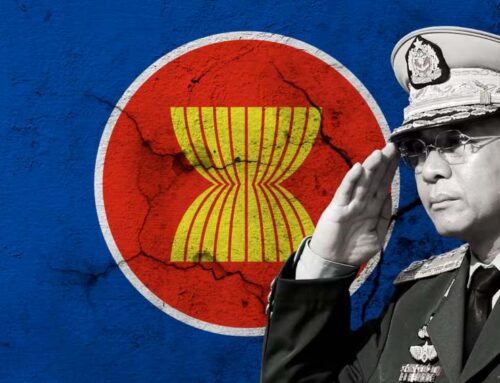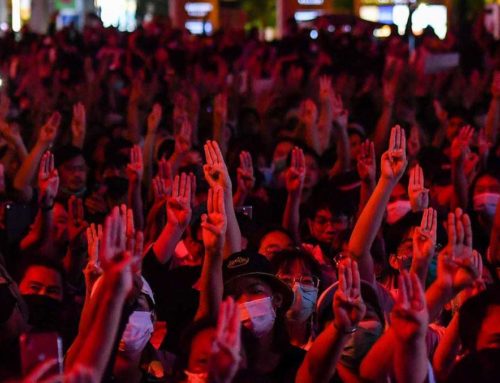The rise and rise of Bangladesh
The economy is booming. Does Sheikh Hasina deserve the credit?{1st Photo Caption: Sheikh Hasina is running for a third five-year term as prime minister of Bangladesh. (Original photos by Akira Kodaka)}
COVER STORY
The rise and rise of Bangladesh
The economy is booming. Does Sheikh Hasina deserve the credit?
GWEN ROBINSON, Editor-at-large, Nikkei Asian Review
DECEMBER 19, 2018 13:19 JST
DHAKA — Bangladesh defies economic and political gravity. Since its 1971 war of independence with Pakistan, the country has been known for its tragedies: wrenching poverty, natural disasters and now one of the world’s biggest refugee crises, after the influx of 750,000 Rohingya Muslims fleeing persecution in neighboring Myanmar.
Yet, with remarkably little international attention, Bangladesh has also become one of the world’s economic success stories. Aided by a fast-growing manufacturing sector — its garment industry is second only to China’s — Bangladesh’s economy has averaged above 6% annual growth for nearly a decade, reaching 7.86% in the year through June.
From mass starvation in 1974, the country has achieved near self-sufficiency in food production for its 166 million-plus population. Per capita income has risen nearly threefold since 2009, reaching $1,750 this year. And the number of people living in extreme poverty — classified as under $1.25 per day — has shrunk from about 19% of the population to less than 9% over the same period, according to the World Bank.
Earlier this year, Bangladesh celebrated a pivotal moment when it met United Nations criteria for graduating from “least developed country” status by 2024. To Prime Minister Sheikh Hasina, the elevation to “developing economy” means a significant boost to the nation’s self-image.
“Exiting LDC status gives us some kind of strength and confidence, which is very important, not only for political leaders but also for the people,” she told the Nikkei Asian Review in an exclusive interview in December. “When you are in a low category, naturally when you discuss terms of projects and programs, you must depend on others’ mercy. But once you have graduated, you don’t have to depend on anyone because you have your own rights.”

Despite its automation push, Giant Group still employs thousands of workers. (Photo by Akira Kodaka)
Hasina says Bangladesh’s strong economic growth will not just continue, but accelerate. “In the next five years, we expect annual growth to exceed 9% and, we hope, get us to 10% by 2021,” she said.
“I always shoot for a higher rate,” she laughs. “Why should I predict lower?”
On many fronts, Bangladesh’s economic performance has indeed exceeded even government targets. With a national strategy focused on manufacturing — dominated by the garment industry — the country has seen exports soar by an average annual rate of 15-17% in recent years to reach a record $36.7 billion in the year through June. They are on track to meet the government’s goal of $39 billion in 2019, and Hasina has urged industry to hit $50 billion worth by 2021 to mark the 50th anniversary of what Bangladeshis call their Liberation War.
A vast community of about 2.5 million Bangladeshi overseas workers further buoys the economy with remittances that jumped an annual 18% to top $15 billion in 2018. But Hasina also knows the country needs to move up the industrial value chain. Political and business leaders echo her ambitions to shift from the old model of operating as a low-cost manufacturing hub partly dependent on remittances and international aid.
To that end, Hasina launched a “Digital Bangladesh” strategy in 2009 backed by generous incentives. Now Dhaka, the nation’s capital, is home to a small but growing technology sector led by CEOs who talk boldly about “leapfrogging” neighboring India in IT. Pharmaceutical manufacturing — another Indian staple — is also on the rise.

The government is now implementing an ambitious scheme to build a network of 100 special economic zones around the country, 11 of which have been completed while 79 are under construction.
The concept neatly capitalizes on Bangladesh’s record population density, leveraging what Faisal Ahmed, chief economist at Bangladesh Bank, calls the “density dividend. “The proximity of our population also helped us design and spread social and economic ideas such as microfinance and low-cost health care. But we need to better manage our scarce land resources, and part of the answer is to develop well-functioning industrial parks and SEZs,” he said.
Behind the impressive numbers and bold ambitions, however, are daunting hurdles ranging from structural problems to deep political divisions, which have come to the fore ahead of national elections on Dec. 30.
Bangladeshi politics have been dominated for years by the bitter rivalry between Hasina and former Prime Minister Khaleda Zia, whose family histories go back to opposing sides of the liberation struggle, when Bangladesh was known as East Pakistan. Both women have been in and out of power — and prison — over the past three decades. Khaleda Zia, who chairs the opposition Bangladesh Nationalist Party, is in jail on corruption charges that she says are false.
Since 1981, Hasina has led the ruling Awami League, founded by her father, Sheikh Mujibur Rahman, the country’s first president, who was killed by army personnel along with most of his family in 1975. The party enjoyed strong support in some past elections. But opposition activists and human rights groups have voiced concern about potential polling fraud and intimidation tactics. After two consecutive five-year terms for the ruling party, analysts point to a palpable “anti-incumbency” sentiment among some voters. Yet from an economic standpoint, many agree that a ruling party victory would support further development.
“If the polling passes without too much strife and the status quo is maintained, then [Bangladesh] would seem an attractive long-term story,” said Christopher Wood, managing director and chief strategist at Hong Kong-based brokerage CLSA.

The crowded streets of Dhaka (Photo by Akira Kodaka)

A shopping mall in Dhaka: Bangladesh is on track to become a “developing country” in 2024. (Photo by Akira Kodaka)
Speaking at her official residence in central Dhaka, the prime minister rejected local and international criticism of creeping authoritarianism. Her party, she insisted, is “committed to protecting democracy in Bangladesh.”
Business seems largely on the ruling party’s side — if only for stability’s sake. In recent interviews in Dhaka, executives and political analysts dismissed suggestions that political turbulence could derail the country’s growth trajectory.
“We feel relieved that all political parties are participating in the elections,” said Faruque Hassan, managing director of Giant Group, a leading garment manufacturer, and senior vice president of the Bangladesh Garment Manufacturers and Exporters Association. “We feel positive that despite political differences we can continue to keep economic issues separate — although we know that without political stability you can’t grow, and you could scare international customers.”
Tailoring its industrial policy
The ready-made garment industry is a key factor in the country’s phenomenal success story. The industry is the country’s largest employer, providing about 4.5 million jobs, and accounted for nearly 80% of Bangladesh’s total merchandise exports in 2018.
It has undergone seismic changes since the watershed Rana Plaza disaster in 2013, when a multi-story garment factory complex collapsed, killing more than 1,130 workers. In the aftermath, the industry was forced by international apparel brands to implement sweeping reforms, including factory upgrades, inspections and improved worker conditions.
A visit to one of Giant Group’s gleaming factories brings home the industry’s rapidly changing dynamics. In a vast room a handful of workers oversees a fully automated operation that feeds fabric and thread into a huge machine that cuts, stitches and turns out finished garments. In another space nearby, about 300 workers, mostly women, operate machines that embroider and add applique to garments.

Giant Group has introduced a high level of automation at its garment factories. (Photo by Akira Kodaka)

Giant Group says it aims to move into more value-added areas, such as embroidery and high-performance materials. (Photo by AKira Kodaka)
“Our entire industry changed in just 90 seconds in April 2013, generally for the better,” said Hassan of Giant. “We don’t actually want 100% automation — hopefully we can offset the impact by shifting more workers into value-added fields, applique, embroidery and so on.”
Further investment is needed if Bangladesh’s garment industry is to remain competitive.
“Bangladesh is still dominated by more basic products and cotton, whereas growth worldwide has been in man-made fibers. We need more investment in these areas, not to produce more cotton shirts,” he said.
Bangladesh’s textile industry could gain if China’s garment exports are hit by a prolonged U.S.-China trade war. But other garment centers are also taking aim at a vulnerable China, including Vietnam, Turkey, Myanmar and Ethiopia.
Intensifying international competition has already sparked consolidation in Bangladesh’s garment industry, reducing the number of factories by 22% in the last five years to 4,560, according to the BGMEA.
CLSA’s Wood believes that Bangladesh’s reliance on the garment sector is a potential obstacle to future growth. “This sector on a 10-year view faces the risk of cheap wage alternatives such as Africa, automation and the loss of duty-free market access if Bangladesh transitions from LDC status [as scheduled for 2024],” he said.
“For now the challenge is to develop other sectors, with pharmaceuticals and business process outsourcing being two areas of promise. But this will require much more foreign investment,” he said.

FDI is not Bangladesh’s strong point. While it nearly tripled during Hasina’s nine years in office, from $961 million in fiscal 2008 to nearly $3 billion in the year to June 30, this compares poorly with other Asian countries, including Vietnam and Myanmar.
Government officials partly blame the country’s consistently low rankings in the World Bank’s annual “Ease of Doing Business” survey, which they fear deters foreign investors. The latest survey, issued in December, put Bangladesh at 176th of 190 countries, citing excessive red tape, poor infrastructure and transport.
The government has moved to streamline the investment process with the creation of a “one-stop” investor service intended to replicate similar services in Singapore and Vietnam. But this has yet to gain momentum.
More successful is Hasina’s digital push. With her son, a U.S.-educated tech expert, as a key adviser, the program has introduced generous tax breaks for the information and communications technology sector and a sweeping scheme to build 12 high-tech parks across the country.
In Dhaka, a new generation of IT entrepreneurs talks about beating India — which leapt onto the global map with its basic outsourcing industry — by focusing on AI, robotics and disruptive technologies.

Bangladesh’s exports of software and IT services reached nearly $800 million in the year to June 30 and are on track to exceed $1 billion this fiscal year. The government’s target of reaching $5 billion in ICT-related exports by 2021 is “very, very challenging but achievable,” said Habibullah Karim, CEO of software company Technohaven and a co-founder of the Bangladesh Association of Software & Information Services, an industry body.
“From $800 million to $5 billion is a sixfold increase in three years. That’s tough in itself. The second challenge is that the global outsourcing market is actually shrinking,” Karim said. “Many tasks, such as airline and hotel reservations and insurance claims … are now fully automated.”
There have been outstanding homegrown tech successes, such as ride-sharing service Pathao, which received a $2 million investment from Indonesian unicorn Go-Jek, and mobile financial services group bKash, in which Alipay, an arm of China’s Alibaba Group Holding, took a 20% stake in April.
But go-ahead industries badly need more financing, said Khalid Quadir, CEO and co-founder of Brummer & Partners (Bangladesh), which manages Frontier Fund, the country’s only private equity fund. He argues that innovation thrives on a strong private equity industry that can channel funds to promising companies and help them list.

After decades of turmoil, Bangladesh has become South Asia’s fastest-growing economy. (Photo by Akira Kodaka)

Employees work at of Technohaven’s office in Dhaka. (Photo by Akira Kodaka)
“We have invested nearly $200 million over the years in areas including communications infrastructure, garments and pharmaceuticals. It’s a drop in the ocean compared to the growth opportunities on offer. But to attract more capital of this kind, regulation could be more investor-friendly,” he said, citing three-year lockup provisions on investments in newly listed companies.
Shameem Ahsan, chairman of IT company eGeneration and a former head of BASIS, sees Bangladesh’s tech niche at the cutting edge of IT. “Forty years ago, the garment industry started with a few companies. Now Bangladesh is exporting $30 billion-plus worth and is second only to China. We want to do the same thing in the IT industry,” he said.
Bangladesh is hoping to challenge India in pharmaceuticals, too. With its “least developed country” status, the country has enjoyed a waiver on drug patents. This has fueled intensifying competition between India and Bangladesh in the field of generic and bulk drugs. Among local star performers is Incepta Pharmaceuticals, Bangladesh’s second-largest generics maker, which exports to about 60 countries, and Popular Pharmaceuticals, which is eyeing an eventual listing.
“When you look at U.S. and Europe … their manufacturing plants are closing and they are coming to Asia. Why? Because of quality, affordable drugs,” said Syed Billah, senior general manager at Incepta. “We have the quality and recognition from international regulatory bodies, and are very good at finished products. But in [bulk drugs], we are far behind, and seeking technology for that from China.”
One of Bangladesh’s competitive disadvantages is its poor infrastructure, and the country has turned to China for help. Under its Belt and Road Initiative, China has financed various megaprojects in Bangladesh, including most of the nearly $4 billion Padma Bridge rail link, which will connect the country’s southwest with the northern and eastern regions. In all, China has committed $38 billion in loans, aid and other assistance for Bangladesh.

China’s heavy infrastructure investment has drawn criticism of its “debt diplomacy” in other countries, including Pakistan and Sri Lanka. But local economists dismiss such concerns.
“I don’t think Bangladesh is being pulled too far into China’s orbit like Pakistan or even Sri Lanka,” said Faiz Sobhan, senior director of research at the Bangladesh Enterprise Institute, an independent think tank, noting that the country is also reliant on Japanese infrastructure investment.
Hasina said the government is taking a more proactive role in the financing alongside international partners such as China, Japan and international financial institutions. “We have undertaken to establish our own sovereign wealth fund, worth $10 billion, to bankroll long-term physical infrastructure development. This is possible because our foreign exchange reserves stand at more than $32 billion now, from $7.5 billion 10 years ago.”
Chinese investors also bought 25% of the Dhaka Stock Exchange in 2018, and Bangladesh is now the second-largest importer of Chinese military hardware after Pakistan.
While some may question so much investment from Beijing, Hasina said it is simply a fact that China is set to play a bigger role in the region.
“Our foreign policy is very clear: friendly relations with everyone,” she said. “What China and U.S. are doing, it is between them.”
Additional reporting by Nikkei staff writers Mitsuru Obe and Yuji Kuronuma, and Dhaka contributor Abu Anas
Source Link: NIKKEI ASIAN REVIEW
Related Articles:
Bangladeshi voters wary of ruling party despite economic growth – Nikkei Asian Review
COVER STORY – Side story
Bangladeshi voters wary of ruling party despite economic growth
Critics of Prime Minister Hasina say little chance that polls will be fair
Sheikh Hasina, Bangladesh’s PM, in her own words – Nikkei Asian Review
COVER STORY – Excerpts from interview
Sheikh Hasina, Bangladesh’s PM, in her own words





